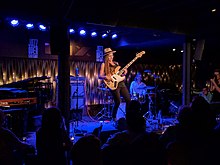Gustav Siegle House

The Gustav-Siegle-Haus - today called the Philharmonie Gustav-Siegle-Haus - on Leonhardsplatz in Stuttgart-Mitte goes back to the industrialist Gustav Siegle (1840–1905) ( G. Siegle & Co. ). The building, built between 1910 and 1912 according to plans by Theodor Fischer , still serves as a venue for music, art and education today.
history
After Gustav Siegle died in 1905, his widow Julie, together with her daughters and sons-in-law, founded a foundation named after him in 1907 , which was last endowed with 700,000 gold marks . The aim of the Gustav Siegle Foundation was to serve popular education without distinguishing between religious and political tendencies. In order to provide the foundation with the necessary premises, the Gustav-Siegle-Haus was built by Theodor Fischer in the romantic style from 1910 onwards. When excavating the construction pit, it turned out that the site was a former cemetery (Leonardsfriedhof until 1805). The official inauguration of the representative building at Leonhardsplatz 28 between Bohnenviertel and Leonhardskirche was on October 6, 1912.
Between 1930 and 1980 there was the Leonardsbad opposite the Gustav-Siegle-Haus , designed as a counter-statement to the Heslach indoor swimming pool .
The Württemberg Minister of the Interior, Johann von Pischek , head of the foundation and friend Gustav Siegles, declared in his inauguration speech that the Gustav-Siegle-Haus should “facilitate and open up access to a solid education of the mind and the heart for members of the broadest circles of the people, and thus giving your life increased value and increased joy ”.
During the Second World War , the Gustav-Siegle-Haus was destroyed in 1944 in heavy air raids. The Gustav Siegle Foundation was dissolved in 1949 and the remaining assets after inflation and currency reform were transferred to the city of Stuttgart. The building was rebuilt in 1953/1954 by the architect Martin Elsaesser , a student of Fischer, whereby Elsaesser largely based on the original plans.
present
The building, called the Philharmonie Gustav-Siegle-Haus since the renovation in 2000 , continues to serve as an event location for education and culture. Numerous concerts, lectures and workshops take place here. It has a large hall with almost 500 seats and a small one with more than 150 seats. The Stuttgart Philharmonic also has its seat (and a rehearsal hall) in the Philharmonie .
On March 6, 2007, the “Art District” opened in the Gustav-Siegle-Haus, a non-commercial gallery for art from the Stuttgart region.
Bix jazz club
On December 16, 2006, the Bix Jazzclub, named after the jazz trumpeter Bix Beiderbecke , opened in the extension of the Gustav-Siegle-Haus. The program is organized by the non-profit association Jazzcom e. V., the 2003 u. a. was founded by Wolfgang Dauner and Helen Schneider . Well-known musicians such as Joshua Redman , Wynton Marsalis and Manu Katché performed . The club can accommodate around 200 guests and consists of two levels, the actual auditorium on the ground floor and a bar and lounge area on a gallery level where the music is broadcast. Like other jazz clubs in Stuttgart, the Bix is sponsored by the city.
Web links
- Gustav Siegle and the Gustav Siegle House ( Memento from March 12, 2007 in the Internet Archive )
- Stuttgart Philharmonic
- Art district
- Bix jazz club
literature
- Werner Skrentny, Rolf Schwenker, Sybille Weitz, Ulrich Weitz (eds.): Stuttgart on foot: 20 district forays through history and the present . 4th edition. Silberburg-Verlag , Tübingen 2008, ISBN 978-3-87407-813-9 .
- Sigrid Brüggemann, Roland Maier: On the trail of Jewish life - seven forays through Stuttgart. Butterfly Verlag Stuttgart 2019. ISBN 3-89657-144-3 . Page 194-199.
Coordinates: 48 ° 46 ′ 22 " N , 9 ° 10 ′ 48" E

